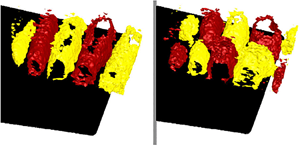Published online by Cambridge University Press: 09 December 2021

This paper presents an experimental investigation of aerofoil tones emitted by a controlled-diffusion aerofoil at low Mach number ( $0.05$), moderate Reynolds number based on the chord length (
$0.05$), moderate Reynolds number based on the chord length ( $1.4 \times 10^{5}$) and moderate incidence (
$1.4 \times 10^{5}$) and moderate incidence ( $5^{\circ }$ angle of attack). Wall-pressure measurements have been performed along the suction side of the aerofoil to reveal the acoustic source mechanisms. In particular, a feedback loop is found to extend from the aerofoil trailing edge to the regions near the leading edge where the flow encounters a mean favourable pressure gradient, and consists of acoustic disturbances travelling upstream. Simultaneous wall-pressure, velocity and far-field acoustic measurements have been performed to identify the boundary-layer instability responsible for tonal noise generation. Causality correlation between far-field acoustic pressure and wall-normal velocity fluctuations has been performed, which reveals the presence of a Kelvin–Helmholtz-type modal shape within the velocity disturbance field. Tomographic particle image velocimetry measurements have been performed to understand the three-dimensional aspects of this flow instability. These measurements confirm the presence of large two-dimensional rollers that undergo three-dimensional breakdown just upstream of the trailing edge. Finally, modal decomposition of the flow has been carried out using proper orthogonal decomposition, which demonstrates that the normal modes are responsible for aerofoil tonal noise. The higher normal modes are found to undergo regular modulations in the spanwise direction. Based on the observed modal shape, an explanation of aerofoil tonal noise amplitude reduction is given, which has been previously reported in modular or serrated trailing-edge aerofoils.
$5^{\circ }$ angle of attack). Wall-pressure measurements have been performed along the suction side of the aerofoil to reveal the acoustic source mechanisms. In particular, a feedback loop is found to extend from the aerofoil trailing edge to the regions near the leading edge where the flow encounters a mean favourable pressure gradient, and consists of acoustic disturbances travelling upstream. Simultaneous wall-pressure, velocity and far-field acoustic measurements have been performed to identify the boundary-layer instability responsible for tonal noise generation. Causality correlation between far-field acoustic pressure and wall-normal velocity fluctuations has been performed, which reveals the presence of a Kelvin–Helmholtz-type modal shape within the velocity disturbance field. Tomographic particle image velocimetry measurements have been performed to understand the three-dimensional aspects of this flow instability. These measurements confirm the presence of large two-dimensional rollers that undergo three-dimensional breakdown just upstream of the trailing edge. Finally, modal decomposition of the flow has been carried out using proper orthogonal decomposition, which demonstrates that the normal modes are responsible for aerofoil tonal noise. The higher normal modes are found to undergo regular modulations in the spanwise direction. Based on the observed modal shape, an explanation of aerofoil tonal noise amplitude reduction is given, which has been previously reported in modular or serrated trailing-edge aerofoils.